 1916: the first quarter of the animated cartoon bowl is underway. Winsor McCay observes from the sideline after John Bray punched the ball from his hands and filed enough patents to dominate the field. Max and Dave Fleischer eagerly signed on with Bray. Paul Terry was there too, grudgingly, after Bray dropped a flag on the play when Terry tried to open his own franchise. Young Walter Lantz ran a camera for Hearst’s International Film Service, where Bill Nolan and Grim Natwick landed after a big player buyout that left Raoul Barré injured and nearly out of the competition.
1916: the first quarter of the animated cartoon bowl is underway. Winsor McCay observes from the sideline after John Bray punched the ball from his hands and filed enough patents to dominate the field. Max and Dave Fleischer eagerly signed on with Bray. Paul Terry was there too, grudgingly, after Bray dropped a flag on the play when Terry tried to open his own franchise. Young Walter Lantz ran a camera for Hearst’s International Film Service, where Bill Nolan and Grim Natwick landed after a big player buyout that left Raoul Barré injured and nearly out of the competition.
Barré’s relief, more of a respite, came in the form of a comic strip duo named Mutt and Jeff.
Bud Fisher created Mutt and Jeff in San Francisco, a city with considerable animation pedigree. Paul Terry’s brother John had the Movca Film Service there, cranking out knock-off Charlie Chaplin cartoons with Jerry Shields. Pinto Colvig and Boyington Ford operated a studio there before the First World War, Willis O’Brien’s initial forays into stop-motion took place in Frisco.
After some local success, Bud Fisher took Mutt and Jeff to William Randolph Hearst and made them nationally famous. Fisher leased out the rights for some live-action comedy movies, forming the Bud Fisher Film Corporation. Stage producer Gus Hill signed for exclusive rights to any “dramatic representation” of Mutt and Jeff, so the movies were discontinued.
Fisher retained all rights to comic strip usage. By 1916 Bud Fischer was living in a Manhattan loft on the ninth floor at 373 4th Avenue. The comic strip was going strong. Gus Hill’s play pulled in the crowds, bringing Fisher a healthy sum in royalties. He decided to put Mutt and Jeff into animated cartoons.
Herbert Miles, who’d set up the first film exchanges in California, also migrated from San Francisco to New York. Miles invested money to save the failing Union Photoplay Company at 286 Fifth Avenue. Charles R. Macauley had organized Union Photoplay a couple years earlier after being fired from the New York World because of political activities. Macauley produced a live-action version of ALICE IN WONDERLAND, and some half-reel animations for the Strand Theater, before running into financial difficulties. Herbert Miles bailed Charles Macauley out. They reorganized in the Candler Building as the Kine Cartoon Film Corporation.
Kine Cartoons raided the print media for the best artists, including Percy Crosby of the New York World; Foster M. Follett of the New York Sunday World; and noted political cartoonist Frank Nankivell. Kine Cartoon Films didn’t last long, but it did bring Follett and Nankivell into the animation business.
Notable among the growing ranks of animators was Harry S. Palmer. He’d studied art in Europe and illustrated for newspapers all around the U.S. before returning to New York. Palmer next made a name for himself as a war correspondent and artist while on assignment abroad, even covering the Boxer Rebellion in China. The Centaur Film Company of Bayonne, New Hersey employed Palmer to animate a series called MADE IN AMERICA CARTOONS. After the fourth film Harry Palmer went to Flushing, Queens to work on KRITERION KOMIC KARTOONS for the Pyramid Film Company.
 At Pyramid Palmer had Denver, Colorado newspaper artist Clyde Spencer assisting. The whole animation department was only four men, expected to turn out five-hundred feet of film per week. Half-a-dozen films were completed before Palmer moved over to Gaumont’s studio in Flushing. Gaumont secured rights to make cartoons of Arthur Momand’s newspaper strip KEEPING UP WITH THE JONESES. Production on KEEPING UP WITH THE JONESES was interrupted when John Bray sued Harry Palmer for patent infringement early in 1916, so Gaumont had Palmer start a SEE AMERICA FIRST cartoon series, and then another known as KARTOON KOMICS.
At Pyramid Palmer had Denver, Colorado newspaper artist Clyde Spencer assisting. The whole animation department was only four men, expected to turn out five-hundred feet of film per week. Half-a-dozen films were completed before Palmer moved over to Gaumont’s studio in Flushing. Gaumont secured rights to make cartoons of Arthur Momand’s newspaper strip KEEPING UP WITH THE JONESES. Production on KEEPING UP WITH THE JONESES was interrupted when John Bray sued Harry Palmer for patent infringement early in 1916, so Gaumont had Palmer start a SEE AMERICA FIRST cartoon series, and then another known as KARTOON KOMICS.
Billing himself as “the Apostle of Fun”, Carl Francis Lederer produced and directed four cartoons on New York. Leon Searl, who’d animated for Hearst at IFS, worked on Lederer’s films. Vitagraph released the first two, while the Lubin Manufacturing Corporation handled the others. Lubin also distributed Leon Searl’s MILE-A-MINUTE MONTY cartoon. Lederer took a job at the Barré Studio and focused his efforts on patenting an optical system to improve animation backgrounds.
So, New York hosted an active animation scene by 1916 when Bud Fisher decided to get into the field. At that time, Charles Bowers did editorial illustration for newspapers at his studio in Mount Vernon, the town just north of the Bronx. Bowers worked out an arrangement with Bud Fisher. They formed the Mutt and Jeff Cartoon Company to make animations of Fisher’s newspaper strip characters. Bud Fisher opened a Times Square sales office in the Studebaker Building. Charles Bowers made arrangements with Raoul Barré in the Bronx to use the Fordham Arcade Building space. They formed a partnership as the Barré-Bowers Studio. Publicity releases made it appear Fisher directed each film himself, while in fact, he was not involved with production.
Charles Bowers, a dynamo of energy, animated and directed MUTT AND JEFF while Barré handled other projects. Hungarian-born Adolph Zukor distributed MUTT AND JEFF on a state’s-rights basis. Public response to Bray’s COLONEL HEEZA LIAR and BOBBY BUMPS cartoons had always been favorable, if not overly enthusiastic. The same held for William Randolph Hearst’s IFS toons. But something exciting happened here. Within three months of the first release film exchanges were calling for MUTT AND JEFF to be turned out at a faster rate so they could meet the demand from exhibitors. Hearst claimed the right to produce his own Mutt and Jeff cartoons because the comic appeared in his newspapers. Bud fisher filed an injunction, forcing Hearst to back off. Then, as a Canadian citizen, Bud Fisher was drafted into World War One and sent to Europe. MUTT AND JEFF became even more popular while Fisher was overseas.
Bud Fisher returned to New York in 1917, discharged at the rank of Captain. Residing at 258 Riverside Drive, he used the 4th Avenue loft as a studio. Fisher learned that while he was in uniform Charles Bowers made some power-plays in his absence. Bowers had started the Mutt and Jeff Film Exchange and brokered a state’s rights deal for William Fox to distribute MUTT AND JEFF domestically in place of Zukor’s Celebrated Players.
Fisher responded by forming the Bud Fisher Film Corporation for the purpose of assigning international release rights for MUTT AND JEFF to Marcus Loew’s Jefferson Film Corporation, located at 1493 Broadway. New York native Manny Gould joined the Barré-Bowers Studio. The unprecedented success of MUTT AND JEFF inspired others to up their game. Harry Palmer left Gaumont to start his own studio in the Studebaker Building. PALMER’S CARTOONS were distributed by the Educational Films Corporation of America, housed across the street in the Godfrey Building. None of this panned out for Palmer and he soon returned to newspaper illustration.
Success caused a number of problems for Bud Fisher. He was back in court after Gus Hill refused to pay any more royalties from the stage plays. Hill claimed MUTT AND JEFF cartoon screenings in movie theaters caused ticket sales of their live theater shows to drop. Hill asserted that those animated cartoons violated the exclusivity clause of his contract with Fisher. In fact, Gus Hill declared that Bud Fisher owed him damages. The crux of the debate was whether animated cartoons, being drawings, were closer to newspaper strips, or being films, were dramatic representations the same as stage shows. Either way, Fisher continued producing cartoons, and the number of other animation shops in Manhattan continued to increase.
The Screen Sketching Service, owned by animator Alex Cruickshank, set up next to the Lyceum Theater in the Tilmar Building at 145 West 45th Street. German artist Luis Seel moved into the Tilmar Building as well with his Animated Title & Cartoon Company, leaving his war-torn homeland behind. America entered the First World War in 1917. German troops were killing U.S. troops on European battlefields. William Randolph Hearst’s support of German policies caused some people to brand Hearst a traitor. The millionaire publisher suddenly had money troubles. In the summer of 1918 Hearst dismissed the entire IFS staff, but kept the company name intact. By December the war ended with the U.S. and its allies victorious.
Hearst’s publishing empire survived, but the shut down at IFS sent Burt Gillett and Isadore “Izzy” Klein Bronxward to work at the Barré-Bowers Studio, where animator Dick Friel acted as shop supervisor. On Friel’s crew were a couple veterans of the Kine Cartoon Film Corporation, Foster M. Follett and Frank Nankivell, whose daughter Edith assisted in the camera department. After Kino, Follett had animated QUACKY DOODLES for Bray Studios, while Nankivell supervised cartoon ads for the Dra-Ko Film Company at 1451 Broadway.
Bowers occupied the manager’s office concocting stories, while his secretary Grace Stafford sat in the business office filling out exposure sheets used to pace the films. Barré didn’t like Bowers and wasn’t around much. Occasionally Bud Fisher breezed through with a showgirl, or two, hanging on his arm. Vernon Stallings was there, and a new guy, Dick Huemer, an up-and-comer. Huemer dropped out of high school to do a year at the Art Students’ League before joining Barré-Bowers as a tracer. Dick Huemer’s natural talent soon moved him in among the men and women of the inking department. Ted Sears did lettering.
Raoul Barré learned Charles Bowers was cheating him and, in a fit of rage, threatened to shoot Bowers. Police took Barré to a sanitarium for psychological observation before releasing him. Barré broke up the partnership, returning to the less stressful world of newspaper illustration. Bowers remained in the Fordham Arcade Building turning out MUTT AND JEFF cartoons.
The Fox Film Corporation received a steady stream of letters from theater owners stating how popular MUTT AND JEFF cartoons were. Some considered them the most important films on the bill. Everything seemed rosy until shop supervisor Dick Friel informed Fisher that Bowers pocketed money. Fisher investigated, firing Bowers and promoting Friel to manager. Fox Films started sending a guy around to check on their interests.
Bud Fisher made a deal for the Jefferson Film Company to take over Production. The Jefferson Film Company bought all contents of the studio, along with Dick Friel and Grace Stafford’s contracts. Somehow Bowers convinced Fisher to give him another chance. A second MUTT AND JEFF production studio was set up in a two-story brick building next to the Mount Vernon City Hall. Izzy Klein helped Bowers organize the place. Between Mount Vernon and the Bronx, a MUTT AND JEFF cartoon got released every week. Meanwhile Manhattan got more crowded with animation studios.
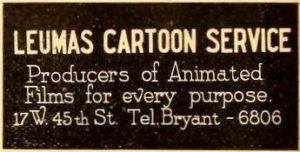 The Leumas Cartoon Service popped up at 17 West 45th Street in 1919, advertising heavily as “producers of animated films for every purpose”. Leumas was the brain-child of respected Broadway costume designer Samuel Zakud. Leumas vanished as quickly as it appeared.
The Leumas Cartoon Service popped up at 17 West 45th Street in 1919, advertising heavily as “producers of animated films for every purpose”. Leumas was the brain-child of respected Broadway costume designer Samuel Zakud. Leumas vanished as quickly as it appeared.
The Daniels Studio in the Candler Building was garnering a reputation for animated titles and trailers done by the team of Frederick Dahme and Luis Seel. Late in 1919 they became Screen Follies, Incorporated, taking out full page ads in the trade publications to promote their up-coming weekly animated SCREEN FOLLIES, promising to render “plenty of beautiful women”.
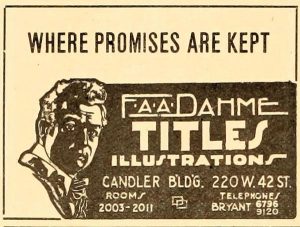 Harry Palmer tried again, having purchased rights to a newspaper strip called A REGULAR FELLOW, but it was hard to replicate the phenomenal success of MUTT AND JEFF. Frederick Dahme and Luis Seel’s SCREEN FOLLIES were well received when they appeared in 1920, but ended after a few releases. Luis Seel returned to his native Germany, involving himself in the Munich film scene. That August Fred Dahme reorganized as F.A.A. Dahme, Inc., maintaining the space spread about the Candler Building’s second floor and continuing with advertisement animation and movie titles. The Candler Building, named for the owner of Coca Cola, housed several film production companies. Simplex manufactured projectors on 34th Street, setting up rentable screening rooms on the Candler’s fifth floor. Simplex augmented business with a lab for editing, doing titles and animated ads on the third floor. The Art Film Company at 45 West 45th Street also animated titles.
Harry Palmer tried again, having purchased rights to a newspaper strip called A REGULAR FELLOW, but it was hard to replicate the phenomenal success of MUTT AND JEFF. Frederick Dahme and Luis Seel’s SCREEN FOLLIES were well received when they appeared in 1920, but ended after a few releases. Luis Seel returned to his native Germany, involving himself in the Munich film scene. That August Fred Dahme reorganized as F.A.A. Dahme, Inc., maintaining the space spread about the Candler Building’s second floor and continuing with advertisement animation and movie titles. The Candler Building, named for the owner of Coca Cola, housed several film production companies. Simplex manufactured projectors on 34th Street, setting up rentable screening rooms on the Candler’s fifth floor. Simplex augmented business with a lab for editing, doing titles and animated ads on the third floor. The Art Film Company at 45 West 45th Street also animated titles.
Les Elton produced the animated IT’S A BEAR independently, releasing it through Universal. Elton received a patent on his process for combining animation and live-action. He put it to use on a series called CINEMA LUKE. Three of those were made as part of the Universal Screen Magazine.
During 1920 Dick Friel sent Foster M. Follett and Ted Sears to the MUTT AND JEFF studio in Mount Vernon to augment Charles Bowers’ crew. Additions to that staff included cartoonists Louis Glacken, Leighton Budd, and newbie Carl Meyers. At the Bronx MUTT AND JEFF studio Bill Tytla got hired to letter title cards. Ben Harrison arrived from Massachusetts hoping to be a newspaper cartoonist, only to clean up pages for MUTT AND JEFF. Manny Gould befriended Ben Harrison. Seventy cartoons were released in the series that year.
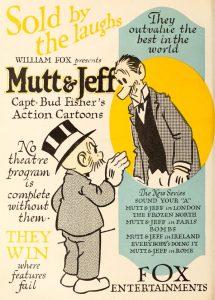 Early in 1921 Dick Friel left MUTT AND JEFF to write for a live-action studio. Burt Gillett became production manager at the Fordham Arcade locale. Output dropped to half. Mutt and Jeff were still very popular, but a little black cat named Felix appeared to challenge them. The unpredictable Bowers vacated the Mount Vernon shop. He moved into a two-story building a mile or so up Webster Avenue from the Fordham Arcade. The second floor was actually smaller, because of a roof patio above half the first floor. Bowers closed the Arcade Building location, cramming Gillett and all the animators into that tiny second floor. Bowers used the spacious ground floor to experiment with stop-motion puppets for his own projects. Bowers still wrote cartoons for MUTT AND JEFF. Gillett resented Bowers’ intrusion.
Early in 1921 Dick Friel left MUTT AND JEFF to write for a live-action studio. Burt Gillett became production manager at the Fordham Arcade locale. Output dropped to half. Mutt and Jeff were still very popular, but a little black cat named Felix appeared to challenge them. The unpredictable Bowers vacated the Mount Vernon shop. He moved into a two-story building a mile or so up Webster Avenue from the Fordham Arcade. The second floor was actually smaller, because of a roof patio above half the first floor. Bowers closed the Arcade Building location, cramming Gillett and all the animators into that tiny second floor. Bowers used the spacious ground floor to experiment with stop-motion puppets for his own projects. Bowers still wrote cartoons for MUTT AND JEFF. Gillett resented Bowers’ intrusion.
An audit of Bud Fisher’s company ledgers showed his cartoon production companies were nearly bankrupt, partly from Fisher’s own lavish spending, and partly from more of Bowers’ creative bookkeeping. Fisher fired Bowers again. Production dropped again, but the series still did well. The Bud Fisher Film Corporation and the Mutt and Jeff Cartoon Company were deactivated. All business was done through the Jefferson Film Company.
By 1922 Paul Terry and Max Fleisher had both broken loose of Bray to open their own studios. Other little shops came and went. The Animated Advertising Company could be found at 160 West 46th Street, and the Animated Advertising Service at 130 West 42nd Street. Early that year, just as Bud Fisher’s contract with the Jefferson Film Company ended, the Jefferson Film Company changed its name to the Supreme Cartoons Corporation, continuing to make MUTT AND JEFF.
A single MUTT AND JEFF cartoon got released in 1923. During that lull in production Burt Gillett, Manny Gould, Dick Huemer and Ben Harrison all took jobs with Max Fleischer. Dick Friel, already distanced from the Mutt and Jeff quagmire, went to work for The Lee-Bradford Corporation at 701 Seventh Avenue. Arthur Lee and F. G. Bradford imported British films to the U.S. Now they branched out and made eleven RED HEAD COMEDIES cartoons. Dick Friel wrote and directed, animating alongside Frank Nankivell, Walter Stark, and newspaper cartoonist Andrew “Hutch” Hutchison. The theme concerned humorous takes on history with titles like CLEOPATRA AND HER EASY MARK; WHAT DID WILLIAM TELL; and WHY SITTING BULL STOOD UP. Kelley Laboratory, over in New Jersey on the Palisades, developed a system of layering multiple negatives to make color film. RED HEAD COMEDIES used the Kelley process, being the first animated series in color. After that Lee and Bradford moved on to other things.
Reel Colors, Incorporated used the Kelly process that same year for HISTORIETS, which were presented as: illustrated, animated and “Cartoonized” in “Multi-Color”. Reel Colors had a lab in Lyndhurst, New Jersey, but the art studio was at 85 Riverside Drive in Manhattan. HISTORIETS covered: Famous Sayings of Famous Americans; Love Affairs of Famous Men; Witty Sayings of Famous Frenchmen; Witty, Naughty Thoughts; and Lives of Famous Stars. The series was short-lived.
Luis Seel returned from Germany in 1924, moving back into the Candler Building, this time on the third floor, just as Simplex wound down its animation lab there. Seel’s gimmick was to produce a new “leader” for theaters every month. His old partner Fred Dahme was now a competitor, having moved to the Tilmar Building.
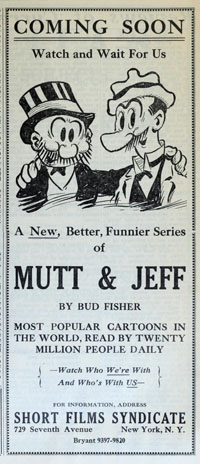 Not a single Mutt and Jeff cartoon was made in 1924. Bud Fisher did win his lawsuit with Gus Hill, retaining the right to make his cartoons, which were judged to be distinct from live-action movies. Whatever went on between Bud Fisher and Charles Bowers evades my comprehension. With Fisher’s permission once again, Bowers revived MUTT AND JEFF in 1925. Fox Films were no longer involved. The Short Films Syndicate, in the Godfrey Building, would distribute.
Not a single Mutt and Jeff cartoon was made in 1924. Bud Fisher did win his lawsuit with Gus Hill, retaining the right to make his cartoons, which were judged to be distinct from live-action movies. Whatever went on between Bud Fisher and Charles Bowers evades my comprehension. With Fisher’s permission once again, Bowers revived MUTT AND JEFF in 1925. Fox Films were no longer involved. The Short Films Syndicate, in the Godfrey Building, would distribute.
Bowers found space in Long Island City, in a three-story frame building on Jackson Avenue near Queen’s Plaza. Bowers set up in the drafty third floor loft as the Charles Bowers Studio. Burt Gillett, Ben Harrison, Manny Gould, and Izzy Klein all came back for more. Burt Gillett’s brother Clyde owned a camera and animation stand, so he was hired to run that department. Partitions, shelves, cabinets, and drawing boards converted the empty loft into a studio. Bowers was hardly ever around. He spent most of his time at another space in Astoria working on puppets. Burt Gillett looked after the Jackson Avenue shop. Sid Marcus, an experienced animator from IFS, was brought in. George Rufle from Pennsylvania signed on.
Burt Gillett, Ben Harrison, and Manny Gould staged a coup, evicting Bowers from the Jackson Avenue loft, renaming it Associated Animators. When they went to lunch Bowers came in with a moving crew and stripped the place down to the walls, leaving nothing but Clyde Gillett’s camera and stand. Associated Animators rallied to get production going. It was a precarious industry. Alex Cruickshank’s Screen Sketching Service still held on. The Animated Advertising Service was now at 239 West 42nd Street with different owners. Associated Animators moved a few doors down the block from there to the 200 West 42nd Street. New Yorkers still loved MUTT AND JEFF but their popularity waned out in the sticks. Associated Animators stayed afloat doing segment called FUN FROM THE PRESS for a screen magazine produced by Literary Digest. W. W. Hodkinson distributed.
A guy named Lester Cornwall started L. B. Cornwall, Inc. in the Studebaker Building. Cornwall’s vice president, William A. Gilmartin, had animated for Hearst’s IFS, then gone into magazine sales when that all fell apart. Gilmartin and Al Rose animated the EBENEEZER EBONY series. These were distributed through the Wilson Exchange in the Godfrey Building. The Wilson Exchange was part of Sering D. Wilson & Company, which acquired rights to the Kelley Color process In March 1925. Sering D. Wilson, at 25 West 43rd Street, sent Frank A Nankivell and Andrew Hutchison to the Tilmar Building, where they made KARLO KOLOR KOMEDIES starring Karlo the Dog. The Wilson Exchange also distributed reissues of Lee-Bradford’s RED HEAD COMEDIES. Florida investors soon bought the entire Sering operation and moved it south to do live-action production.
In 1926 the Animated Advertising Service could be found at 582 Ninth Avenue, soon to be gone for good. That summer Bill Nolan, Milt Gross, Vernon Stalling, Dick Friel, and several others convened at the Richmond Hotel on Staten Island for the First Annual Animated Cartoonists Dinner. Charles Bowers was back for one last hurrah in 1926, doing fourteen MUTT AND JEFF cartoons at his Astoria studio. That space, 75 Mill Street, was also listed as 37-19 First Avenue, a couple blocks from the 92nd Street Ferry terminal. All cartoons Bowers made were released through the Short Films Syndicate. At the end of that year Bowers abandoned MUTT AND JEFF for good and began acting in a line of live-action “Bowers Comedies”, using stop-motion animation among his bag of special effects tricks.
Mutt and Jeff appeared in newspapers and comic books for decades to come, but their days as animated cartoons were over.




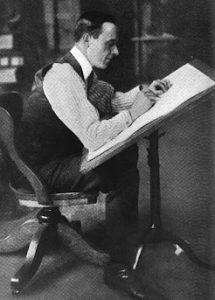
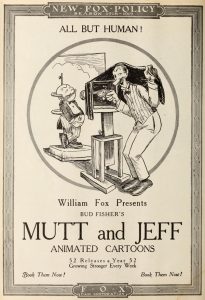
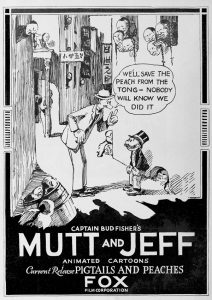
 BOB COAR made his way in this world as a muralist and sign painter, illustrating on just about every surface imaginable. A life-long fan of animation, he is currently searching for digital, or actual, copies of Top Cel.
BOB COAR made his way in this world as a muralist and sign painter, illustrating on just about every surface imaginable. A life-long fan of animation, he is currently searching for digital, or actual, copies of Top Cel. 



































Bob,
Thank you for your incredible research. My first 8mm projector came with a 50′ cutdown of a Mutt and Jeff cartoon that I watched over and over again. A great read.
Luis Seel’s origins seem to be a subject of contention. Rolf Giesen and J. P. Storm, in ANIMATION UNDER THE SWASTIKA: A HISTORY OF TRICKFILM IN NAZI GERMANY, 1933-1945, claim that Seel was born in Wiesbaden in 1881; they also state that some sources (unspecified) say he was born in 1889 in Deidesheim, over 100 km to the south. However, in his Cartoon Research post for 12 July 2021 (BRAZIL: ANIMATED BEGINNINGS), Milton Knight maintains that much of the biographical information on Seel has conflated him with a German painter of the same name. According to Knight, Seel was born in America in 1890 and only relocated to Germany in 1919. In any case, Seel was a pioneer in establishing an animation industry in three countries: the USA, Germany and Brazil.
Although Bud Fisher did indeed serve in the British Army during WWI, he was actually born in Chicago. How was he a Canadian citizen? Were his parents from Canada? As far as I know, he never lived there.
Frank Nankivell was an Australian. Before coming to America he spent several years in Tokyo drawing cartoons for an English-language magazine. During this time he was a mentor to Rakuten Kitazawa, who later became the first professional cartoonist in Japan, known as “the father of manga”. I had no idea Nankivell ever worked in animation — and with Raoul Barre and Charley Bowers, no less!
Bud Fisher’s March, 1918 passport application is available on ancestry.com. As part of the file, apparently Max, Lord Beaverbrook (the newspaper proprietor) had recruited Fisher to join his staff, hence the passport application. The passport application states that his father (Albert) was born in West Virginia. It wasn’t unheard of for Americans to join Imperial Forces — recall from this site that A.C. Gamer (the effects animator) volunteered for the RAF (as did Raymond Chandler, the author). Take this with a grain of salt, but the March 3, 1918 edition of the Lincoln Star newspaper said that Fisher had been commissioned a lieutenant in the U.S. Army — and had requested a transfer to the British Army! Allegedly because he (Fisher) was anxious to go to Europe, and the Beaverbrook connection is mentioned. (One reason I’m dubious about the article is that there’s a possibly tongue-in-cheek reference to Fisher having served with Pancho Villa.) Ancestry.com has data suggesting he did join the U.S. Army in January, 1918.
I’ve checked a bit further. There is a record on ancestry of Fisher being appointed a 2nd Lt. in the Field Artillery in November, 1917 at the Plattsburg (NY) barracks, being assigned to Camp Meade, and then honorably discharged in February, 1918. So some of what’s in the newspaper articles checks. Oddly, the record I just cited has his birth year as 1884, not the correct 1885.
Bud Fisher, like Percy Crosby and many other cartoonists — indeed many celebrities as well as thousands of men from the middle and upper classes — did volunteer military training in the Plattsburgh camps, mainly Plattsburgh, NY, itself. It was semi-governmental. Pres Woodrow Wilson, a virtual pacifist, thought that the Plattsburgh System, inspired by Theodore Roosevelt and managed by his old friend Gen Leonard Wood, would “let off steam” of the growing “Preparedness” movement. This is all before American intervention in the Great War. Also, Fisher was not alone, driven by patriotic if not militaristic fervor (jumping into a war was still a romantic idea) in volunteering to serve with British or Canadian forces. (Roosevelt’s son Kermit, in fact, was in British uniform in Mesopotamia). After the US entry in the War, Fisher gave the strip over to Ed Mack; Mutt and Jeff were in uniform; and strips were signed “Fisher, somewhere in France.” Percy Crosby drew servicemen cartoons; Milt Gross drew cartoons in Navy publications.
Approximately, how many “Mutt and Jeff” cartoons still exist of the nerealy or so hundreds? They seem to be one of the more harder long-form animated series of the silent era to find.
Over 300 were produced. All 26 of the Associated Animators cartoons survive, but no more than two dozen of the earlier Mutt and Jeffs survive. The Little Ferry Fire in 1937 destroyed the masters, and since the cartoons were seen more disposable by this point, and being so early into their lives, most of them only existed inside the vault
Nice work, Bob! However, you’re confusing Grace Stafford with Grace ASHTON. Grace Stafford was Walter Lantz’s wife, later voicing Woody Woodpecker in the 1950s, of course.
My bad!
Great overview!
On an unrelated subject, Bob, I’ve read a fair bit about the Lindbergh kidnapping and was wondering, are you at all related to the police detective Robert Coar who was involved in that investigation?
Not that I’m aware/
My first exposure to the animated “Mutt and Jeff” were the redrawn, colorized version of the Associated Animators shorts that was done in the 1930s and released through Modern Film Sales. I’m wondering if anyone knows who was responsible for those colorized versions? This was long before Fred Ladd got involved in colorizing B&W cartoons.
I remember that “Mutt & Jeff Meet Bugoff” thing that re-edited the colorized M&J cartoons.
The comic strip was originally titled “A. Mutt” and first appeared on the sports page of “The San Francisco Chronicle” in 1907. (Augustus Mutt was a gambler who bet on horse races and other sports, hence its location in the paper). It is widely credited as the first successful daily comic strip; up until then, comics appeared only in Sunday papers.
The strip dispensed tips to horseplayers (a few other comic strips did this, including “Asparagus Tipps”). Mutt met his lifelong pal during one storyline where he was incarcerated in “the bughouse,” and encountered a guy who imagined he was boxer James Jeffries (known as “Jeff” to his fans).
Fantastic research, thank you! My head’s spinning even from your orderly presentation of it all—-I can’t imagine how much work it must’ve been sorting it all out!
Bowers sure sounds quite the manipulator. I worked for someone once who was taken by the same charlatan two or three times. Each time he came back it was to make things right—then he’d just rip him off again. When a man like that finds the right good-hearted victim, he can take him time and again.